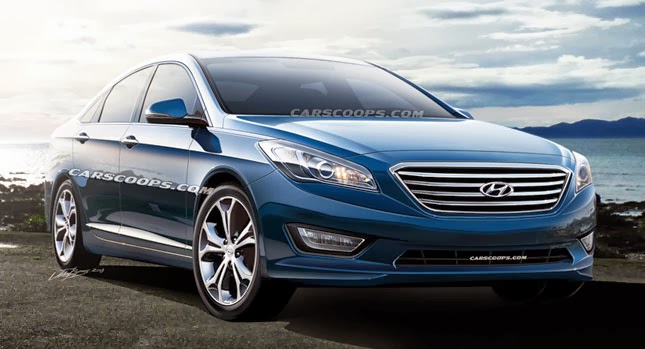A few years back, any talk about Hyundai with my motoring-minded friends usually descended into an all-out laugh slaughter at the expense of the Korean automaker. Fast forward to today, and those long-lasting prejudices are now largely invalid. Hyundai isn’t a brand to be ridiculed – it’s a company fast improving their vehicle portfolio, taking their fight right up to the established and traditional main players.
One model that has made people stand up and take notice is the current generation Sonata mid-size sedan (known as i45 in some markets). When revealed in 2009, it was a breath of fresh air compared to the rather staid Toyota Camry, Honda Accord, Ford Fusion and Nissan Altima of the late 2000’s.
However, the car industry forever marches forward and those competitors mentioned have since all undergone serious makeovers. Latest versions of the Mazda6 and Ford Fusion would arguably be the current mid-size style leaders, so how does Hyundai’s next Sonata stack up?
The Look:
‘Fluidic Sculpture’ was the defining styling theme of the outgoing Sonata; some people loved its unique appearance while others thought it resembled a melted plastic container. Regardless, it has been largely well received and Hyundai doesn’t want to startle the punters with something completely radical – hence why the automaker has taken a slightly cautious approach with its replacement by using its new ‘Fluidic Precision‘ design language.
Looking like a cross between the European/Asia Pacific market Hyundai i40 and upcoming Genesis sedan, the next Sonata embodies a classier, less adventurous approach with a large dominant chrome grille, part-LED headlights and imposing hood. The side profile is a mix of ‘been there and done that’ – while the strong shoulder lines make it visually pleasing, it could almost be from any other carmaker. The view at the back is rather chiseled, with LED taillights wrapping horizontally into the trunk lid. Chrome-tipped dual exhausts sit tastefully at the bumpers lower edge, further emphasizing Hyundai’s upmarket approach.
The Inside View:
Cabin changes will be vast – a new dashboard design debuts with squared off and angular surfacing details. Touchscreen navigation and infotainment controls sit higher up between the air-vents for easier reach and viewing. While aesthetically not as free-flowing as the current car, expect perceived quality to improve with strategic use of chrome, soft-touch plastics and piano black trim details.
Access to the roomier rear seats should be easier than the current car’s head-bagging arrangement, although the roofline is still rather sleek, so headroom still appears be at a premium.
Will It Be Safe?
Yes. The outgoing generation has earned high marks in Insurance Institute for Highway Safety (IIHS) crash tests. Expect the 2015MY version to offer better protection in the relatively new small overlap crash test – something that has shown up weaknesses in a vast number of competitor vehicles. Avoiding the proverbial altogether is the best option, and this should be achievable through driver assists like automatic braking, lane keeping aid, radar cruise control and blind spot monitoring.
What Drives It?
Rumor has it that Hyundai will be taking a forced-induction route, with a 1.6-Liter Turbo shared with the eccentric Veloster coupe and a carry-over 2.0-Liter turbocharged for higher-grade versions. Don’t expect any V6 options, as that’s reserved for the company’s larger rear wheel drive offerings. Those who enjoy hyper-milling will be relieved that the Hybrid will also be returning – albeit there’s still no word on a plug-in hybrid option. Regardless of power-train choice, gains in fuel economy will be across the board due to improvements with aerodynamics, weight saving techniques and transmission tweaks.
Power will be transferred to the pavement via the front wheels, and it remains to be seen whether AWD will be offered for those who live in colder climates. Having such an option would potentially allow Hyundai to pilfer sales from the popular Subaru Legacy and Ford Fusion AWD.
How Will It Handle?
The current Sonata can be described as competent when it comes to cornering; however, it’s off the pace compared with rivals like the Mazda6. We can only hope issues with soft suspension and remote steering feel are addressed with the next generation vehicle. Don’t expect an all-new platform to help things dramatically – Hyundai are sticking to the current architecture, however it will be massaged and re-worked to improve interior packaging and torsional stiffness.
Due to be launched late next year as a 2015 model, it will face off against rivals in a fiercely competitive segment. Opposition from Honda, Toyota, Ford, Nissan and Mazda won’t make progress easy – and then there’s the large unknown from its upstart internal sibling – the next generation Kia Optima.
So what do you think? Has Hyundai served up just another car to blend in with the motorway masses or does it exude a breath of fresh air into a segment of four-door beige? Tell us your feedback in the comments section below.
By Josh Byrnes
Photo Renderings Copyright: Carscoops / Josh Byrnes
PHOTO GALLERY





![2015-Hyundai-Sonata-1[3] 2015-Hyundai-Sonata-1[3]](https://www.carscoops.com/wp-content/uploads/2013/09/a3afc468-2015-hyundai-sonata-125255b325255d25255b325255d-300x163.jpg)
![2015-Hyundai-Sonata-3[3] 2015-Hyundai-Sonata-3[3]](https://www.carscoops.com/wp-content/uploads/2013/09/72712e90-2015-hyundai-sonata-325255b325255d25255b325255d-300x163.jpg)
![2015-Hyundai-Sonata-4[3] 2015-Hyundai-Sonata-4[3]](https://www.carscoops.com/wp-content/uploads/2013/09/08381915-2015-hyundai-sonata-425255b325255d25255b325255d-300x163.jpg)
![2015-Hyundai-Sonata-5[3] 2015-Hyundai-Sonata-5[3]](https://www.carscoops.com/wp-content/uploads/2013/09/d48e5f6f-2015-hyundai-sonata-525255b325255d25255b325255d-300x163.jpg)
![2015-Hyundai-Sonata-7[3] 2015-Hyundai-Sonata-7[3]](https://www.carscoops.com/wp-content/uploads/2013/09/f77aae17-2015-hyundai-sonata-725255b325255d25255b325255d-300x163.jpg)
![2015-Hyundai-Sonata-6[3] 2015-Hyundai-Sonata-6[3]](https://www.carscoops.com/wp-content/uploads/2013/09/002d51a6-2015-hyundai-sonata-625255b325255d25255b325255d-300x163.jpg)